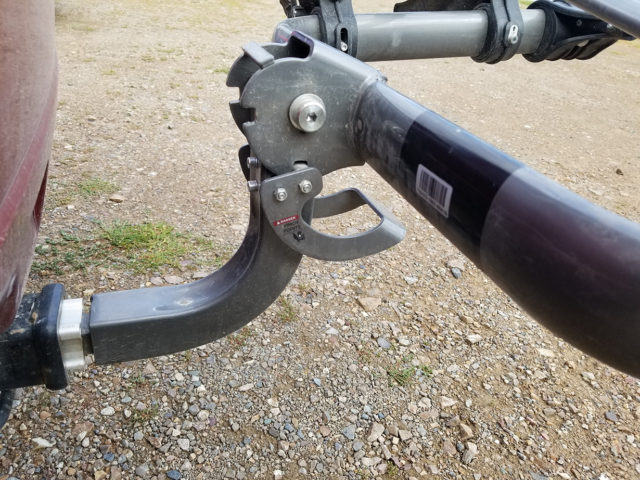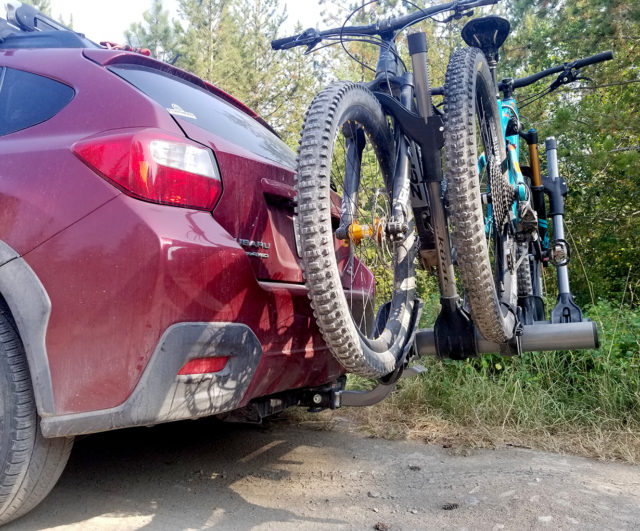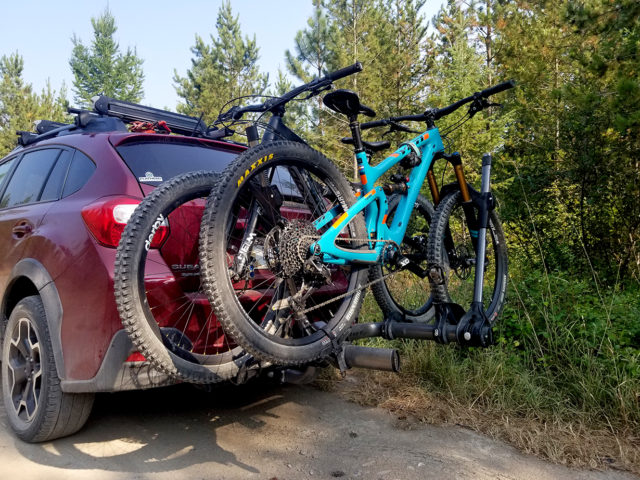
Kuat Transfer Rack
Blister’s Measured Weight (2 bike version): 36 lbs (16.33 kg); 37.8 lbs w/ locks (17.15 kg)
Dimensions: Here
Compatible Wheel sizes: 20” – 29′′, tires up to 4.5” wide.
MSRP:
- 2 bike: $298 (tested)
- 3 bike: $398
Test Location: Around Montana
Test Duration: ~2 months
Intro
If you need to carry a couple / few bikes, hitch racks are great. They don’t kill your car’s gas mileage, loading and unloading bikes is fairly painless, and they’re pretty easy to pull off the car when not in use.
But hitch racks come in a few different styles, and among the less expensive options, the most common ones are hanging-style racks — the rack dangles the bike by its top tube.
I’m here to say that hanging-style racks suck. They don’t work well with swoopy top tubes. They don’t work well with bikes with a rear shock attached to the top tube. They don’t work well with kids’ bikes. The bikes tend to swing around and get scratched up. The contact points on the top tube get scratched up. The rack is in the way of opening the hatchback, regardless of whether bikes are on it or not. I could go on…
Now, vertical hanging racks (e.g. North Shore racks) are great, but they’re not cheap. So in the realm of hitch racks, that more or less leaves us with tray-style racks — racks where the bike’s wheels sit on a tray. These are, by and large, excellent options — the bikes are pretty secure, the rack sits low and out of the way, and there’s minimal contact between the painted parts of the bike and the rack.
But most decent tray racks are still $500+, which leaves a budget-minded traveler with a bit of a conundrum: save some cash and get a hanging rack that’s terrible, or suck it up and shell out for a more expensive tray rack.
And this is where the Kuat Transfer enters the conversation. It’s a tray rack, or at least it functions like one and has the basic upsides of one, but the two-bike version that I tested retails for $298, which makes it one of the most economical tray-style racks on the market.
So that brings us to the question: is it possible to make an inexpensive tray rack that’s actually worth owning?
Features
The Transfer is offered in either a two-bike or three-bike version, and each one fits either 1 ¼” or 2” receiver hitches, although the three-bike iteration can’t go in a class 1 hitch. The hitch slides into the receiver like most other racks, and instead of a hitch pin, a threaded bolt keeps the rack from falling out and also snugs things down to keep the rack from bouncing around.
The basic functionality of the Transfer is pretty similar to a lot of other tray-style racks on the market — each wheel drops into a plastic cradle. A ratchet strap secures the rear wheel, and a ratcheting arm clamps down on the front wheel.
Also similar to most tray racks, the Transfer has three positions — folded up (for when bikes aren’t on it), flat (for when bikes are on it), and tilted down (which allows access to most cars’ trunks, even while bikes are on it. Switching between these positions is done via a lever at the base of the rack, which is pretty easy to access since there isn’t really anything in the middle of the rack to get in the way.

The Transfer doesn’t come standard with locks, but they are available for it. The lock kit runs $39 (for two bikes) and includes locks and cables for the bikes, as well as the hitch lock to secure the rack to the vehicle.
Assembly
The Transfer includes all of the tools needed to put it together, and any semi-mechanically inclined person who can follow directions should be able to assemble it and install it on the car in about 30 minutes or so. On the spectrum of bike racks I have assembled, I’d say the Transfer falls at the easy and less-frustrating end. There are, however, a few bolts that tighten against plastic, and a bit of discretion is required to not over-torque those.
Day to Day Use
I got off to a somewhat rough start with the Transfer — assembly and mounting to the car went smoothly, but one of the ratcheting arms that clamps the front wheel wasn’t holding well, and it wouldn’t stay clamped on the bike. A quick call to Kuat confirmed this was not an intended design feature — they warrantied the part, and I had a replacement arm installed a few days later. Not ideal, but since that little snafu, the ratcheting arms have been working without issue.
In terms of loading and unloading bikes, the Transfer is every bit as easy as pretty much any other tray-style rack I’ve used. One issue with most tray racks is bike to bike conflicts — sometimes a brake lever is resting on a seat, or something of that nature. The Transfer has a flip-chip on each front-wheel cradle that allows the cradle to drop into a lower position, thus lowering the handlebar, and rocking the bike forward a bit. This seemed to work fine, and is a relatively easy change (~30 seconds with a 5 mm hex wrench).

On the road, the rack’s stability was pretty good. Not as good as some of the more expensive tray racks, but far (FAR) better than any hanging-style rack I’ve ever used. There’s a little bit of play in the Transfer’s main pivot point, but a lot of the rack’s instability comes from the large plastic knuckles around the wheel cradles and ratcheting arm.
As far as the locks go, the hitch lock works great — no issues there. The cable locks for the bike are more or less functional, but the cables are pretty short, which makes it difficult to securely lock some bikes. Particularly on bikes with longer-travel forks, I could usually only get the lock around the fork leg. The cables are also just attached to the rack via a bolt with a weird head on it — while most people aren’t going to have the correct wrench for it, removing that bolt effectively unlocks the bike. But, of course, any decent thief probably wouldn’t bother removing the bolt — they’d just cut the cable. In other words, the locks will keep honest people honest, but I certainly wouldn’t entrust the locks with the long-term security of my bike.

I’m a fairly average-sized person, and thus I generally ride average-sized bikes. And all of my average-sized bikes fit into the Transfer without issue — that ranged from a small 26” wheeled dirt jumper to a large 27.5” wheeled DH bike, and assorted 29er Trail bikes. But Kuat says the max wheelbase that’ll fit in the transfer is 47”, which isn’t particularly long. Now, I know for a fact that a longer bike will work alright — my DH bike is closer to a 49” wheelbase, and it fit without issue. But if you’re a big person and you ride huge bikes, you’re potentially going to run into some fitment issues on the Transfer.
Kuat also says the Transfer works with tires up to 4.5” (although you need a longer ratcheting strap, which is sold separately). I didn’t have the chance to test the Transfer with anything bigger than a 2.6” tire, but it seems like there’s plenty of clearance for Plus and fat bike tires.
Downsides
While there are some downsides of the Transfer compared to a more expensive tray rack (which I’ll get into below), most of the Transfer’s downsides are somewhat inherent to the design, and these issues exist on any front-wheel clamp, tray-style rack. For starters, the rack secures the bike by clamping the front wheel up next to the fork. This doesn’t work quite as well (but ok-ish) for bikes with rim brakes, and not very well at all for bikes with long fenders (although Marsh-Guard-type fenders aren’t an issue).
Clamping at the front wheel also means that tire pressure needs to remain somewhat consistent while transporting — fully inflated is fine, completely flat is fine, but a tire that goes flat during the drive can cause the clamp to become loose.
Compared to More Expensive Racks
The Transfer is priced to sell, so what’s it giving up compared to some of the more expensive racks out there? Well, for starters, there’s a decent amount of plastic on the Transfer. Lots of tray racks use plastic around the wheel cups, but the Transfer is a bit more plasticy around the ratcheting arm that secures the bike. And this goes towards the subjective “feel” of the rack — while the Transfer doesn’t feel flimsy, it also generally lacks that feeling of overbuilt sturdiness that you get with some higher-end racks. The flip side of that, however, is that the Transfer is quite light, and thus easier to manage when installing and uninstalling it from the vehicle.
The ratcheting mechanism on the Transfer is also a bit less refined and less smooth than some of the higher-end options. The Transfer’s ratcheting mechanism works, and aside from the aforementioned warranty issue, it hasn’t given me any problems, but it’s not as smooth or confidence inspiring as the ratchets on the top-of-the-line racks. And at least with the higher-end Kuat racks like the NV 2.0, the ratcheting mechanism is internal within the arm, whereas it’s external on the Transfer.

While bike racks in general are rarely impressive from a locking perspective, the Transfer certainly isn’t a game changer on this front. I would say some of the more expensive racks have better locks.
Also, most higher-end racks have some sort of wedge-type stabilizer in the hitch to keep the rack from bouncing around. The Transfer accomplishes this via the bolted hitch pin, which works alright, but it means you need tools to remove the rack.
Compared to Other Inexpensive Tray Racks
At the outset, I said that most of the hitch-mounted racks in this price range are the hanging type, which are terrible. But there are a couple other tray-style racks from Thule and Yakima that are in the same price ballpark as the Transfer. Those racks function a bit differently though — they’re technically tray racks in that the bike sits upright with the wheels in a tray or cradle, but the bike is secured by a clamp that grabs the center of the top tube.
I find there to be a few problems with those sorts of racks. First, they’re clamping onto a painted surface, and they scratch up the top tube. I also find they’re a bit more awkward to load and unload, and they tend to place bikes very close together, which can make for bike to bike conflicts.
Bottom Line
For being a relatively inexpensive rack, the Kuat Transfer does a great job. It has all of the benefits of a tray rack, it’s easy to use, and it comes in a good bit less expensive than most of the other tray rack options.
Is it as good as the higher-end NV 2.0? No. If I was buying a rack to cart around a $5,000 bike five days a week, would I buy a higher-end rack? Yes.
But if I just needed a rack that I was using once or twice a week and didn’t want to shell out for something that cost half as much as my bike, the Transfer would be my pick. To put it another way, when my Mom called me last year and asked me what rack to buy for her car, this is the one I pointed her towards. And that hasn’t changed — if you want a hitch rack and don’t want to break the bank, I think the Transfer is the best option on the market.

I feel like accommodating longer wheel base bikes which have become the norm for larger size bikes in LLS era is a challenge for many tray racks. Rack manufacturers need to play catch up or build in some adjustability. When buying a new bike I seriously looked at how it would fit on the rack I already invested in.
HAVE YOU EVER TESTED A 1-UP RACK? THEY ARE MUCH NICER THAN MOST “PLASTIC” RACKS.
We’ve never reviewed a 1-up, but I’ve used them a fair amount. Great racks, but not really in the same price range as the Transfer. If your budget is $600, then yes, there are quite a few racks that are superior to the $298 Transfer.
i bought one of these when they first came out in 2015. right after i installed it, i got the tip of my right index finger caught between the lever and one of the plates that connects the tray to the mount. chopped the end pretty much clean off. after having it surgically reattached, i contacted kuat about the incident. it might have been a freak accident, but space is pretty tight so it seemed like an easily-remedied design flaw. in response, they sent me a redesigned replacement lever – from what i could tell, it was identical to the original, except it featured a sticker saying something to the effect of “watch your finger”. i recycled both the rack and the new lever